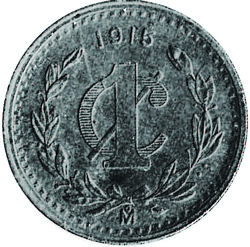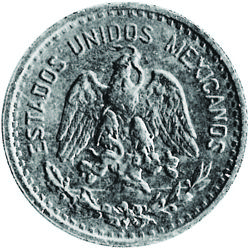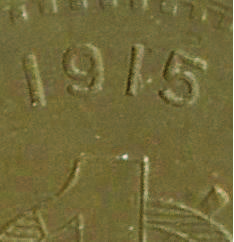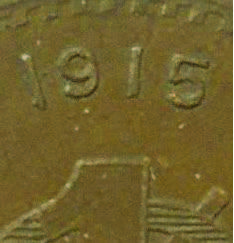Historical Discussion and Documentation of the Varieties of the 1915 Zapatista One Centavo of the Mexico City Mint
by Greg Mayer
The reduced size series is referred to as the ‘Zapata’ centavo because during the Mexican revolution, Emiliano Zapata’s forces, aligned with the Constitucionalistas, controlled Mexico City from 4 December 1914 to 28 January 1915 and then again from 11 March 1915 to the end of July 1915. The Constitutionalist Convention President, Francisco Lagos Chazaro, ordered the reduced size centavo minted on 29 June 1915. The coins saw little circulation with the immediate change of control of Mexico City to Carranza’s forces near the end of July and were formally demonetized on 19 October 1916 José Manuel Sobrino, La Moneda Mexicana: Su Historia, Banco de México, 1972, pp.188-190.
There is no discernible difference between the regular one centavo and the reduced size except for their diameter. An enlarged mint example of the ‘Zapata’ issued reduced diameter centavo is shown below:


Even in mint state these coins are typically found with a weak eagle strike at the breast and the snake is illdefined at that high point of the obverse.
The data I want to focus upon is included in this quote: “numero de piezas emisión bronce $0.01 igual 1,169,048 (julio-diciembre 1915) El total de las piezas de bronce de dos centavos y las ultimas 179,048 piezas de un centavo, fueron emitidas por la Convención, habiéndose reducido el diámetro de las de dos centavos a veinte milímetros y las de un centavo a dieciséis milímetros, únicas acuñaciones hechas con esos diámetros (1,169,048 bronze 1c issued in July-December 1915. All the bronze 2c and the last 179.048 1c were issued by the Convention, having reduced the diameter of the 2c to 20mm and the 1c to 16mm, the only mintage with such diameters)” and the following table from the mintage report, belatedly issued in 1919 Memoria de la Dirección de la Casa de Moneda, y Oficinas Federales de Ensaye, correspondiente al año fiscal de 1915-1916. México, Poder Ejecutivo Federal, Departamento de Aprovisionamientos Generales Dirección de Talleres Gráficos, 1919.
| Piezas | Anversos | Reversos | Acuñados | Troqueles por par de cuños |
| Bronce | 5 | 5 | 990,000 | 198,000 |
| Bronce 16mm | 2 | 2 | 179,048 | 89,254 |
The troqueles or dies are given for both the obverse and reverse of the large and reduced size one centavo series of 1915. So, for the ‘normal’ size 1915 cent there were five of each, giving a minimum of five and a maximum of 25 die pairs to track. What is more interesting is that there were only two dies for each side of the reduced size 1915 one centavo. If one assumes a minimum of two die pairs, then, there are two reverse (dated side) die varieties to analyze. Carlos Amaya, in his Illustrated Price Guide{footnote}Carlos Abel Amaya Guerra, Illustrated Price Guide of the Modern Mexican Coins 1905 to Date, CCEVNM San Pedro Garza García,N.L., Mexico, 2008 , appears to have been the first to report varieties in the Zapata one centavo and he does capture these two varieties but he also identifies two additional subtypes of Type I below.

Type I Reverse Die
Thick 1, narrow date and 5 canted right

Type II Reverse Die
Tall thin 1 canted left, wide and flat date
I put forth the idea that there are no additional subtypes of Type I. As the mintage report for 1915 states, only two dies were made for the reverse of the reduced size one centavo. The variation in these dies is subtle. Great care must be taken when comparing these varieties in magnified photos or scans to ensure that comparable areas are consistently included. In these photos I used the base of the one serif and the edge of the centavo hash to define my bottom and right side crops. The top crop is defined by including just enough of the crenellations to allow counting and then choosing the same crenellation count to define the left edge. In this instance it is the eighth crenellation that defines where the left side crop occurs.
My observations of over 25 of these coins indicate that the Type II variety is found only 20% as often as the Type I and is scarcer. In taking note of the average die strikes in the same year of 1915 at the Mexico City mint, I think it is likely that the first die marriage did not fail at the average indicated in the Memoria for the small diameter centavo, but failed much later. If the first die marriage lasted almost as long as the large 1915 centavo average die strike count (198,000 strikes per die) then the Zapata second die set struck an order of magnitude less planchets (likely less than 30,000) which would support the scarcity of the Type II small diameter variety.
